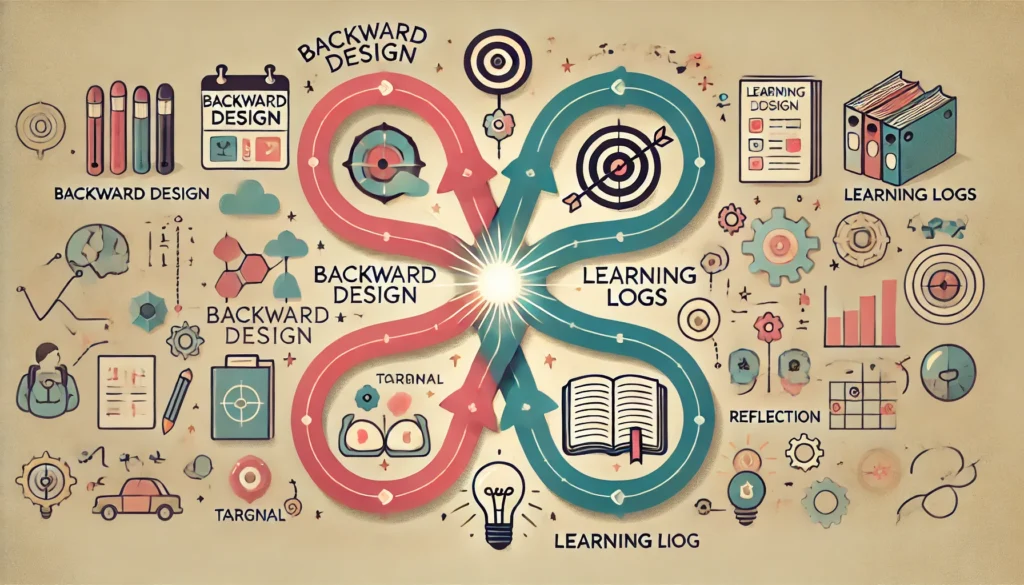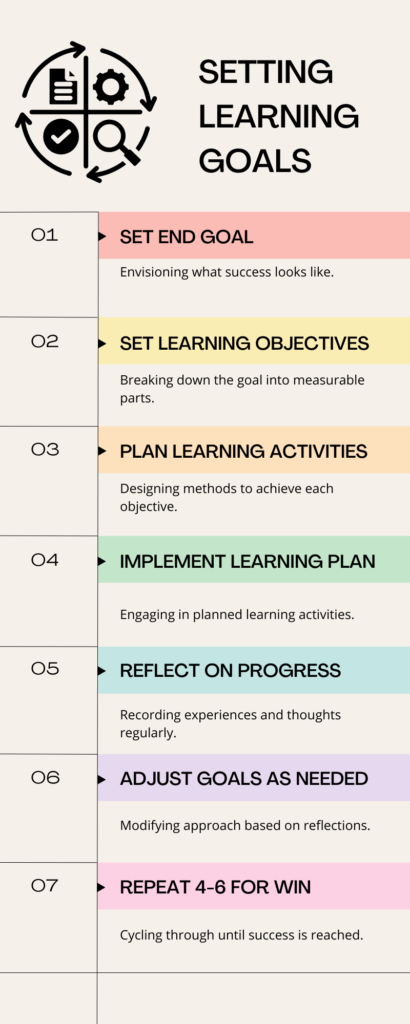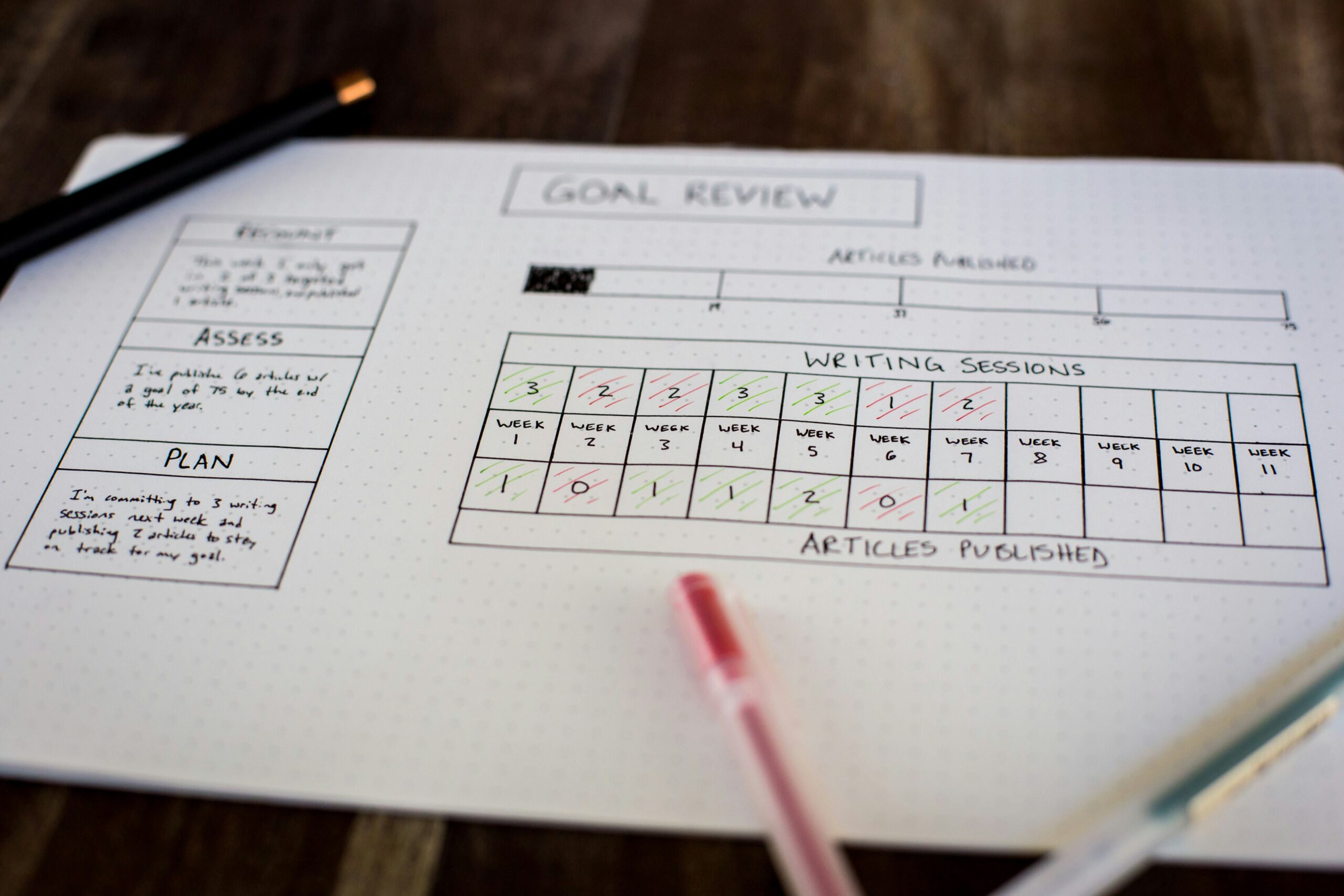Have you ever set out to learn something new, only to find yourself lost in a sea of information, unsure of what you’ve actually accomplished? You’re not alone. In our rapidly evolving world, the ability to set effective learning goals has become more crucial than ever. Whether you’re a student planning your academic journey, a professional charting your career development, or simply someone passionate about lifelong learning, the power to craft clear, actionable learning goals can make all the difference.
But how do you create learning goals that truly drive your growth and keep you motivated? The answer lies in combining two powerful techniques: Backward Design and Learning Logs. In this post, we’ll explore these methods and show you how to implement them to craft learning goals that are not just clear and actionable, but also aligned with your deepest aspirations.
The Power of Backward Design in Goal Setting
Imagine you’re planning a road trip. Would you start by randomly driving in any direction, or would you first decide on your destination? Backward Design applies this common-sense approach to learning.
Backward Design, originally developed by Grant Wiggins and Jay McTighe, is an educational planning approach that starts with the end in mind. Instead of beginning with content and activities, you first define your desired outcomes. When applied to learning goals, this means clearly articulating what you want to achieve before planning how to get there.
Let’s break down the Backward Design process:
- Identify Desired Results: What do you ultimately want to achieve? This is your big-picture goal.
- Determine Acceptable Evidence: How will you know you’ve achieved your goal? What will success look like?
- Plan Learning Experiences and Instruction: What steps do you need to take to reach your goal?
Here’s a real-world example. Meet Sarah, a marketing professional aiming to enhance her data analytics skills. Using Backward Design to set her learning goals, she first defines her ultimate objective: “Implement data-driven strategies to improve campaign ROI by 20% within six months.” With this end goal in mind, she works backward to set specific learning goals, such as mastering Google Analytics, understanding A/B testing, and learning to use data visualization tools.
By starting with her desired outcome, Sarah ensures that every step of her learning journey is purposeful and aligned with her ultimate goal.

Learning Logs: Your Personal Growth Tracker
Now that you’ve set your learning goals using Backward Design, how do you keep track of your progress and ensure your goals remain relevant? Enter Learning Logs.
Learning Logs are reflective journals where you record your learning experiences, thoughts, and progress towards your goals. They serve as a powerful tool for ongoing assessment and refinement of your learning journey.
The power of Learning Logs lies in their ability to enhance metacognition – your awareness of your own thought processes and learning strategies. This self-awareness is crucial for effective goal-setting and achievement, helping you identify what’s working, what isn’t, and how your goals might need to evolve.
Here’s how you can use Learning Logs effectively:
- Regular Entries: Make it a habit to write in your Learning Log daily or weekly.
- Record Experiences: Note what you’ve learned, challenges you’ve faced, and victories you’ve achieved.
- Reflect on Progress: Analyze how your current learning aligns with your goals.
- Identify Patterns: Look for recurring themes or obstacles in your learning process.
- Plan Next Steps: Based on your reflections, decide on your next actions.
Consider Tom, a software developer with a learning goal to master a new programming language. He maintains a weekly Learning Log where he reflects on his progress, noting concepts he’s grasped, challenges he’s facing, and ideas for applying his new knowledge. This practice not only reinforces his learning but also helps him adjust his learning goals as needed, ensuring they remain challenging yet achievable.

The Synergy of Backward Design and Learning Logs
While powerful individually, Backward Design and Learning Logs create a dynamic duo when combined for setting and achieving learning goals. Backward Design provides the framework for setting clear, outcome-focused learning goals, while Learning Logs offer a mechanism for continuous reflection and refinement of these goals.
This combination creates a self-reinforcing cycle of goal-setting, action, reflection, and adjustment. It’s like having a roadmap for your learning journey (Backward Design) and a travel journal (Learning Logs) that helps you navigate, appreciate, and adjust your route as needed.
Emma, a graduate student, uses both techniques to manage her research project. She starts with Backward Design to set her overall learning goal: “Complete a publishable research paper on climate change impacts within 12 months.” She then breaks this down into smaller learning goals for each stage of her research. Using her Learning Log, she tracks her progress towards these goals, reflecting on her learning process and adjusting her goals as her research evolves.
Implementing Your Learning Goal Framework
Ready to revolutionize how you set and achieve learning goals? Here are four strategies to get you started:
- Create a Backward Design template for learning goals Start with a simple three-column table. In the first column, list your ultimate learning objective. In the second, break this down into specific learning goals. In the third, plan the learning activities that will help you achieve each goal. Here’s an example:
| Ultimate Learning Objective | Specific Learning Goals | Learning Activities |
|---|---|---|
| Become proficient in data analysis with Python | 1. Master Python basics for data analysis | 1. Complete Python for Data Science course on Coursera |
| 2. Learn to manipulate and clean data effectively | 2. Practice data cleaning with pandas using real datasets | |
| 3. Develop skills in data visualization | 3. Create 5 different types of plots using matplotlib and seaborn | |
| 4. Apply statistical analysis techniques | 4. Conduct A/B testing and regression analysis on a dataset |
- Start a digital Learning Log focused on your goals Use a note-taking app or a dedicated journaling tool. Set a weekly reminder to reflect on your progress towards your learning goals. Include what you’ve learned, challenges you’ve faced, and how your goals might need to adjust. A simple structure for your Learning Log entries could be:
- What I learned this week
- Challenges I encountered
- How this relates to my learning goals
- Adjustments I need to make
- Next steps
- Set PACT learning goals Frame your learning goals using the PACT framework: Purposeful, Actionable, Continuous, and Trackable. Instead of “Learn data science,” try “Complete one data science project each month, progressively increasing in complexity, and track my learning through project outcomes and skill assessments.” PACT goals ensure that your learning objectives are meaningful, practical, ongoing, and measurable.
- Implement regular learning goal review cycles Schedule monthly learning goal review sessions. Use these times to reflect on your Learning Log entries, assess your progress against your Backward Design plan, and make necessary adjustments to your learning goals. During these reviews, ask yourself:
- Am I making progress towards my ultimate learning objective?
- Are my specific learning goals still relevant and challenging?
- Do I need to adjust my learning activities?
- What insights from my Learning Log can inform my path forward?
Overcoming Common Challenges
As you implement this framework, you might encounter some challenges. Here are a few common ones and how to address them:
- Overwhelm: If you find yourself overwhelmed by the scope of your learning goals, remember that it’s okay to start small. Break your goals down into even smaller, manageable steps.
- Lack of motivation: On days when motivation is low, revisit your ultimate learning objective. Remind yourself why this goal matters to you and how it aligns with your broader life goals.
- Inconsistency: If you’re struggling to maintain consistent Learning Log entries, try linking this habit to an existing one. For example, write in your Learning Log right after your morning coffee or before your evening wind-down routine.
- Rigidity: While structure is helpful, don’t be afraid to adjust your goals as you learn and grow. The beauty of this framework is its flexibility.
Your Learning Goal Revolution Starts Now
Backward Design provides the framework for setting clear, outcome-focused learning goals. Learning Logs serve as your compass, helping you reflect on your experiences and adjust your goals as needed. Together, they create a powerful system for crafting, pursuing, and achieving meaningful learning goals.

Remember, the journey to effective learning starts with a well-crafted goal. Your learning goal revolution begins now – choose one strategy and implement it this week. Your future, more knowledgeable self will thank you!
“The capacity to learn is a gift; the ability to learn is a skill; the willingness to learn is a choice.”
Brian Herbert
Are you ready to make that choice? Start crafting powerful learning objectives today, and watch as your knowledge and skills grow in ways you never imagined possible.
By embracing the Backward Design and Learning Log framework, you’re not just setting goals – you’re creating a roadmap for continuous growth and lifelong learning. So take that first step, set your sights on your learning destination, and enjoy the journey of discovery that awaits you.
References
- Wiggins, G., & McTighe, J. (2005). Understanding by Design. ASCD.
- Locke, E. A., & Latham, G. P. (2002). Building a practically useful theory of goal setting and task motivation: A 35-year odyssey. American Psychologist, 57(9), 705–717.
- Moon, J. A. (2006). Learning Journals: A Handbook for Reflective Practice and Professional Development. Routledge.
- Schön, D. A. (1983). The Reflective Practitioner: How Professionals Think in Action. Basic Books.
- Doran, G. T. (1981). There’s a S.M.A.R.T. way to write management’s goals and objectives. Management Review, 70(11), 35-36.

